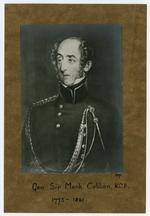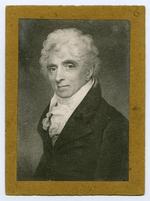The Collet family papers were inherited by Sir Mark Edlmann Collet (1864-1944), with the majority of the material relating to Buchan, Wilks, Cubbon and Collet ancestors.
Sir Mark Edlmann Collet
Sir Mark Edlmann Collet was the son of Sir Mark Wilks Collet (1816-1905), a merchant and banker and Antonia Frederica Edlmann (1824-1919). His mother was the daughter of Joseph Frederic Edlmann (c.1794-1857), an Austrian merchant and Mary Ann Agassiz (1799-1850). Collet had a strong association with the Isle of Man and was a member of a large and distinguished Manx family. The family name was originally Corlett, but through his grandfather (James Collet b.1784) the name was changed to Collet. Mark Edlmann Collet was the great-grandson of John Corlett (1757-1840) and Anne Wilks (1758-1839) and thus his great-great grandfather was Revd James Wilks (1717-1777), Vicar-General of the Island.
Through the Wilks association, Collet was a great-great nephew of Colonel Mark Wilks (1759-1831) and the first cousin twice removed of Lady Laura [née Wilks] Buchan (1797-1888). Collet was also the first cousin twice removed of Sir Mark Cubbon (1785-1861).
Collet was educated at Eton College and then Trinity College, University of Cambridge. In 1888 he married (Nina) Emma Caroline Theobald (c.1864-1922) in Hampshire (couple had no children). In 1905 Collet inherited his father's Baronetcy, the seat being St Clere, Kemsing, Sevenoaks. Living in Kent, in 1913 Collet was the High Sheriff, a Justice of the Peace and County Councillor. In 1931 Collet married Violet Florence Frederica Edlmann (c.1875-1963) in the District of Columbia, United States of America; the couple had no children. By 1936 Collet had moved to the Isle of Man where he played a significant role in the community. For example he took an active interest in Ramsey Cottage Hospital being a member of its committee and investment trustee. He was also interest in the Red Cross and was a devoted member of St Stephen's Church, Sulby. Collet died at the age of 80 at his home in Ballamanuagh, Sulby, and is buried in Ballaugh Old Churchyard.
Lady Laura Buchan and Sir John Buchan KCB
Laura Wilks, born in the Isle of Man, was the daughter of Colonel Mark Wilks, a British East India Company (EIC) army officer and Harriet Macleane (c.1773-1806). During her early life her father was stationed in India but by 1813 her father was offered the position of Governor of St Helena. Colonel Wilks and his family were in St Helena when exiled Napoléon Bonaparte (1769-1821) arrived in 1815. It was said Napoléon greatly admired Laura Wilks' elegance and beauty. In 1816 the Wilks family returned to the British Isles and in 1817 Laura Wilks married lieutenant general Sir John Buchan (c.1783-1850) in Edrom, Scotland. The couple had no surviving children.
A distinguished army officer, Sir John Buchan had been a lieutenant in the Scotch Brigade in 1795, captain in a Regiment of Infantry in 1802, major in the 2nd Ceylon Regiment in 1804 and a lieutenant colonel of the 4th West India Regiment in 1809. In 1814 he became a lieutenant colonel attached to the Portuguese army and a colonel by brevet in 1819. He obtained the rank of major general in the Portuguese army and commanded the 7th Portuguese Regiment at the battle of Vittoria (1813), Pyrenees (1813) and Nive (1813) in the Peninsular War (1804-1814). He was also a Knight Commander of the Bath and Companion of the Order of the Star of India. Sir John Buchan's seat was in East Lothian and he and his wife spent their domestic life living in Scotland, London and the Isle of Man. Sir John died in 1850 aged 67 and is buried in Kensal Green, London.
Lady Buchan survived her husband for 38 years and despite living in London she still retained close links with the Island of her birth. Lady Buchan's most notable contribution to the Isle of Man was her encouragement of education. In 1861 Lady Buchan gave money to the boys school King William's College, Castletown and in 1875 Lady Buchan gave further money to found a girl's school in Castletown. Lady Buchan wanted a girl's school 'for the promotion of higher class female education in this Isle'. The school was opened in 1878 and originally had 17 pupils. Initially called the High School for Girls, the school changed its name to The Buchan in honour of its benefactor. Lady Buchan died aged 91 and is buried in Kensal Green, London, alongside her husband.
Colonel Marks Wilks FRS
Mark Wilks, born at Kirk Michael Vicarage, was the son of Revd James Wilks and his second wife Elizabeth Christian (d.1799). He was named after his godfather, Mark Hildesley (1698–1772), Bishop of Sodor and Man (1755-1772). Receiving a good education, Wilks obtained a cadetship in 1781 and by 1782 received a commission in the Madras army of the EIC. From the early seventeenth century onwards the EIC had a presence in India, gradually increasing influence over the ensuing centuries (EIC's rule was officially recognised in 1764). As British control expanded, so too did Indian opposition. This led to a period of great political conflict and wars (such as the Anglo-Indian Wars) when many soldiers such as Wilks were needed.
In 1788 Wilks was appointed fort adjutant at Fort St George, Madras (now Chennai) and gained the promotion of lieutenant the following year. From 1790 to 1792 he acted as brigade-major and aide-de-camp to Colonel James Stuart (d.1793) during the war against the Mysore ruler, Tipu Sultan (1750-1799). By 1793 Wilks was made assistant adjutant-general. In 1793 Wilks married Harriet Macleane at Fort St George; the couple had two children.
Between 1795 and 1799 Mark was granted a leave of absence due to bad health. Returning to the Isle of Man he joined the Royal Manx Fencibles in 1797 as a lieutenant. During his absence Wilks received his captaincy in India and returned to the country in 1798, serving as military secretary and private secretary to the Governor of Madras, Edward Clive (1754-1839). Wilks was next appointed town-major of Fort St. George and from 1803 to 1808 he was political Resident at the Court of Mysore. Attaining the rank of major in 1804, Wilks then obtained lieutenant-colonel in 1808 (he received the title of colonel in 1814).
A further bout of ill-health drew Wilks to the Isle of Man from 1809 to 1811, during which he was elected a member of the House of Keys. 1812 saw his return to India however by 1813 he had resigned from his office and returned to the British Isles. 1813 also saw Wilks marry his second wife, Dorothy Taubman (b.1783) in Bath, Somerset. Dorothy was the daughter of John Taubman (1746-1822), Speaker of the House of Keys. The couple had no children. In the same year Wilks was offered the position of Governor by the EIC in St Helena. Agreeing to rule for a period of three years, his administration was very popular with improvements to agricultural conditions and alterations to the system of land tenure. Wilks was present on St Helena when Napoleon was exiled in 1815. It was said the exiled emperor admired Wilks and thought him an able Governor.
Wilks was a leading authority in his lifetime on Indian literature and history and wrote several works. For example in 1810 he published Historical Sketches of the South of India in an Attempt to Trace the History of Mysoor . A second and third volume was published in 1814. He also translated into English Akhlaq-i-Nasir , (the work of the Persian poet Nasir-al-Din al-Tusi [1201-1274]).
In 1816 he returned to the Isle of Man and settled in his estate of Kirby, the same year saw him re-elected into the House of Keys and in 1818 he officially retired from the EIC's service. In 1823 he was made Speaker of the House of Keys and in 1826 he was elected a Fellow of the Royal Society (FRS). Wilks died in 1831 at Kelloe House, Berwickshire; the residence of his son-in-law Major-General Sir John Buchan.
Lieutenant-General Sir Mark Cubbon KCB
Mark Cubbon, born in Maughold, Isle of Man, was son of the Revd Thomas Cubbon (1739-1828), Vicar of Maughold and Margaret Wilks (1749-1829). The Cubbons are an old Manx family able to trace their ancestors back to the fifteenth century. Mark Cubbon was the nephew of Mark Wilks and through this connection, Cubbon successfully enrolled as a cadet for the EIC's Madras infantry in 1800. In 1801 he was a lieutenant in the 5th Madras Native Infantry; by 1816 he had been promoted to captain and afterwards became an assistant commissary-general. Serving in the Pindari War (1817-1818), Cubbon became deputy commissary-general for the Madras presidency in 1822, promoted to major in 1823 and then lieutenant-colonel in 1826.
In 1831 the inhabitants of the city of Mysore rose against the Hindu Rajah, who had been placed on the throne by Lord Wellesley (1760-1842) but ran a corrupted administrative system. The rising was suppressed but a commission was instigated to examine the causes. Cubbon was one of many called in to investigate; the end result saw Cubbon appointed British Commissioner of Mysore, a post he held for 27 years.
Cubbon was an extremely talented administrator and during his time Mysore became very prosperous. He simplified the revenue and judicial systems, encouraged new agricultural ventures (coffee planting) and maintained the Amrit Mahal (cattle) at Hunsur, which had been established by Sultan Haidar Ali (1721-1782) to improve the breed of cattle. In 1839 Cubbon was made colonel of the 5th Madras native infantry, promoted to major-general in 1846 and lieutenant-general in 1852. He was made a Companion of the Most Honourable Military Order of the Bath (CB) in 1856 and a Knight Commander of the Most Honourable Military Order of the Bath (KCB) in 1857.
Cubbon never married. Suffering from ill health, he retired from post in February 1861 and prepared to return to the British Isles after a 61 year absence. During the long journey home his health declined further and he died at Suez in April 1861; his body was interred in Maughold parish churchyard, Isle of Man. A commemorative equestrian statue of Cubbon can be found in Bangalore as well as Cubbon Road and Cubbon Park in the same city.



